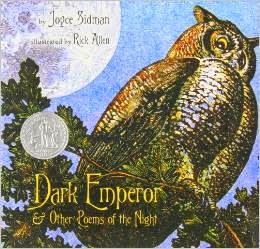In preparation for sharing forms this month, I wrote to a number of poets and asked if they would respond to a short list of questions on poetry, writing, and form. I'm thrilled every time one responds positively and find they have all been extremely generous with their time.
Today I'm sharing the thoughts of Joyce Sidman, author of 13 books, including Winter Bees and Other Poems of the Cold (2014), Dark Emperor and Other Poems of the Night (2010), Ubiquitous: Celebrating Nature's Survivors (2010), Red Sings from Treetops: A Year in Colors (2009) This Is Just to Say: Poems of Apology and Forgiveness (2008), Butterfly Eyes and Other Secrets of the Meadow (2006), Song of the Water Boatman and Other Pond Poems (2005).
How does a poem begin for you--with an idea, a form, an image, or something else?
Joyce: For me, a poem begins with a need to express something I have noticed or felt about the world. But often I cannot start writing until I hear a line, or capture a voice, or experiment with a format. Once I have some structural direction, the need and the emotion and the language begin to come together in a kind of dance.
How do you choose the form of your poems?
Joyce: Hmmm . . . depends on subject matter, maybe? More playful poems might demand rhyme (although not always). I think it is a mysterious process. Sometimes I choose the wrong form, and have to start over again when nothing is working. I'll try another structure, which will give me a different tone.
What surprising things have you learned by accepting the challenge of fitting meaning into a structured form? What are the benefits of accepting these disciplined restrictions?
Joyce: Structure can lead you in unexpected ways. The poem sometimes becomes something it did not start out to be—which can be thrilling but also confusing. You have to constantly monitor meaning vs. impact. I weigh each word, asking myself: Does this add to the meaning, or is it merely a concession to the form? A formal structure can fail miserably, but if it works, it can be a knockout! Helen Frost is a master at this: her poems convey emotion and meaning, but often have some sort of fascinating structure to them as well, that adds a double punch.
What tools (rhyming dictionary, book of forms, etc.) do you use in writing poetry (if any)?
Joyce: I always have my thesaurus and rhyming dictionary at hand, plus several literary manuals I picked up in college and still use. Also, my bookshelves are full of lots and lots of excellent poetry books, which I use for reference and inspiration.
What would you like students or children to know about poetry?
Joyce: That it is as much fun to write as it is to read. That everyone has poems inside them: interesting thoughts, secret observations, unexpected emotions. And there are many, many ways to write poems. Here are some ideas--try them out!
Finally, one of your esteemed colleagues suggested I ask for a poem in a foreign verse form. Would you be willing to share a poem for this project?
Joyce: Tricia, here is a pantoum that has not yet been published, though I use it as a model poem on my website. A pantoum is one of my favorite poem forms, because it repeats lines, shedding new light on them.
Poets.org has a great explanation of the pantoum form. My favorite quote from this explanation is: "An incantation is created by a pantoum’s interlocking pattern of rhyme and repetition; as lines reverberate between stanzas, they fill the poem with echoes."
Spring is the Time
Spring is the time for eggs:
soft air and sprigs of green.
Bright lemon sun,
wet nights singing.
Soft air and sprigs of green,
snug nests and puddles.
Wet nights singing,
feathery days.
Snug nests and puddles—
new life, new hope.
Feathery days,
yellow as yolk.
New life, new hope!
Bright lemon sun,
yellow as yolk.
Spring is the time for eggs.
Poets.org has a great explanation of the pantoum form. My favorite quote from this explanation is: "An incantation is created by a pantoum’s interlocking pattern of rhyme and repetition; as lines reverberate between stanzas, they fill the poem with echoes."
Spring is the time for eggs:
soft air and sprigs of green.
Bright lemon sun,
wet nights singing.
Soft air and sprigs of green,
snug nests and puddles.
Wet nights singing,
feathery days.
Snug nests and puddles—
new life, new hope.
Feathery days,
yellow as yolk.
New life, new hope!
Bright lemon sun,
yellow as yolk.
Spring is the time for eggs.
Poem ©Joyce Sidman, 2009. All rights reserved.
A million thanks to Joyce for participating in my Jumping Into Form project this month.


Wonderful interview– thanks to you both. The pantoum she shared is a beauty. (We had four baby wrens nesting in our front door wreath just flew off to meet the world this week.) I also appreciated what Joyce had to say about fitting meaning into a structured form.
ReplyDeleteWhat Michelle said! Thanks for sharing this, Tricia...and thank you Joyce, for taking the time! Leslie Bulion has always said she likes to have the form appropriate for the subject matter, as well, and it really does make a huge difference.
ReplyDeleteAh, the pantoum is my favorite form, and this is lovely. And what a wonderful description by Poets.org: "they fill the poem with echoes."
ReplyDeleteLove what Joyce has to say about form leading you down unexpected paths. Sometimes the poems just take on a life of their own. Thank you for this interview -- always a pleasure to learn more about Joyce's process.
Great interview! HUGE fan of Joyce Sidman's poetry here!!
ReplyDeleteI love the line, "wet nights singing." Such lovely imagery!